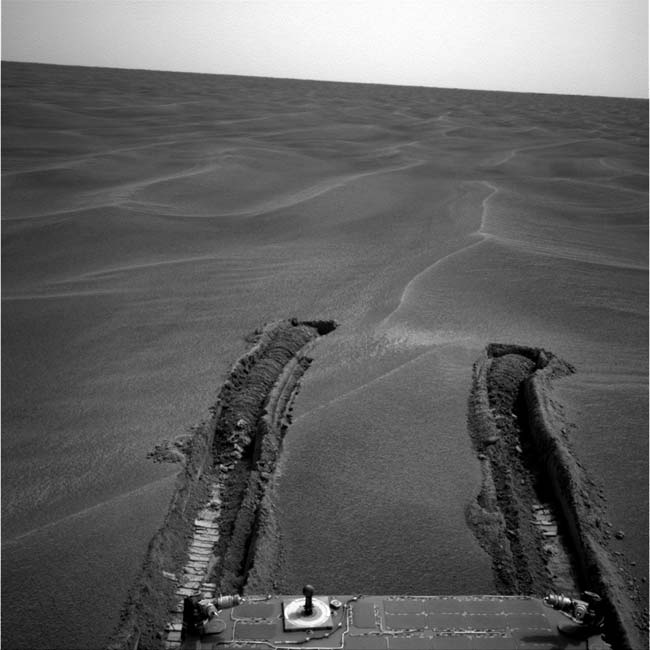NASA Rovers Reach Mars Milestone

Amilestone has been reached for those hard-at-work red planet rovers, Spirit andOpportunity. Late last week, groundcontrollers hit 1,000 sols of working with the robots on the surface of Mars. Asol is durationof a solar day on that faraway planet.
On June 9, Opportunityhit 490 sols and Spirit attained 510 sols since their independent landings inJanuary 2004.
Reaching 1,000 sols "isa remarkable accomplishment," said Steve Squyres,lead scientist for the Mars Exploration Rover (MER) project at CornellUniversity in Ithaca,New York. He tipped his hat tofriends, colleagues and comrades, engineer and scientist alike, on the MERuplink team.
In his Cornell-based website on the Mars rovers, Squyres noted that theEarth-to-Mars uplink process - controlling the robots across interplanetaryspace - "is intense, engrossing and exhausting."
Escape from "Purgatory Dune"
"Goodthings are happening on both sides of the planet," Squyressaid, in terms of robot operations.
AtMeridiani Planum, theOpportunity Mars rover is now free of a sand dune that halted its movement forfive weeks. "At Meridiani, we'll soon begin our firstmaneuvers to reorient the rover so that we can study the feature that gotus...and then be on our way again," Squyres said.
Breaking space news, the latest updates on rocket launches, skywatching events and more!
Themenacing feature that trapped Opportunity nowhas a name: "Purgatory Dune".
"Weweren't calling it anything back when we were stuck in it, but now that we'reout, it seemed there ought to be a name for the thing," Squyresexplained.
Arethere any bestguesses of why that particular dune snagged the rover, and are other sand trapslurking in the area? "No guesses," Squyres told SPACE.com. "We're going to collect dataand then think hard about it...not try to guess."
What information would imagery of Purgatory Dune provide rover groundcontrollers and scientists? There's need to look at grain size, detailedtopography, whether or not the dune has a crust - and if it does have a crust,what that crust is made of, Squyres said. "Basically,everything we can safely learn about it that might be of some help in thefuture."
Spirited spiral: up and to the right
Onthe other side of Mars from where Opportunityrests, the Spirit rover is doing survey work within the Columbia Hills at Gusev Crater.
Spiritis scoping out which way rocks there are tilted. There are very interestingoutcrops in an area dubbed "TennesseeValley", and some "reallygood-looking stuff" on the far wall of the valley, Squyressaid.
TheSpirit rover team has decided to head up on a section tagged as "Husband Hill".
"We'renot going to try a frontal assault this time. Instead, we're going to spiral upand to the right, working both upslope and also cross-slope simultaneously.Whether we'll actually reach the summit is an open question at this point. Butwe're convinced that the route we've chosen offers the quickest path to a viewof whatever's on the south side of the hill... and that's what we want to seenext," Squyres concluded.
- Red Planet Rovers: Complete Coverage

Leonard David is an award-winning space journalist who has been reporting on space activities for more than 50 years. Currently writing as Space.com's Space Insider Columnist among his other projects, Leonard has authored numerous books on space exploration, Mars missions and more, with his latest being "Moon Rush: The New Space Race" published in 2019 by National Geographic. He also wrote "Mars: Our Future on the Red Planet" released in 2016 by National Geographic. Leonard has served as a correspondent for SpaceNews, Scientific American and Aerospace America for the AIAA. He has received many awards, including the first Ordway Award for Sustained Excellence in Spaceflight History in 2015 at the AAS Wernher von Braun Memorial Symposium. You can find out Leonard's latest project at his website and on Twitter.
